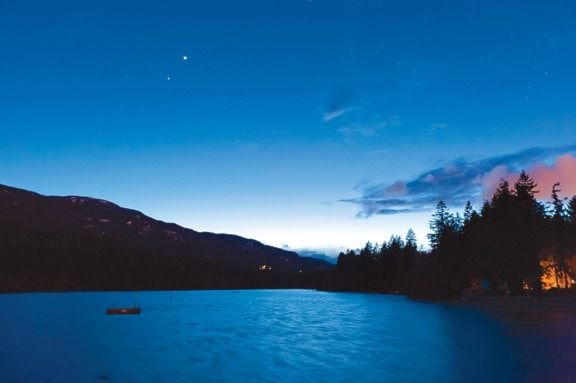The stars have aligned for a group of Nanaimo residents interested protecting the night sky from light pollution.
Members of Nanaimo's Dark Skies Project met for the first time last week to consider establishing a steering committee dedicated to educating people about the night sky and the benefits of preserving it.
Garland Coulson, president of the Nanaimo Astronomy Club, which helped spearhead the project, said reducing light pollution is as much about staying connected to natural wonders as about saving taxpayers' money and reducing greenhouse gases.
"We have three objectives, and those are to work with our local government, work with stakeholders like local business, and participate in public outreach programs to educate people, especially school children, on the importance of preserving our night skies," said Coulson. "In urban areas, night skies are almost all but forgotten."
He cites 911 calls made in San Francisco in the 1990s after a major earthquake. With power outages throughout the city, residents thought a silver cloud was the result of the disaster and reported it to officials.
"It was the Milky Way," said Coulson.
A major project already on the radar of Nanaimo Dark Sky Project is to work with the city to establish Westwood Lake as a Dark Sky Park, with the intent of being sanctioned by the International Dark-Sky Association.
"Westwood Lake is bordered by hills and is at a higher elevation, so it's not as affected as other nearby areas by light pollution," said Coulson. "We already do star walks there, which allows us to show people various features in the night sky like constellations using a laser beam. It's very cool."
A dark sky park is defined as 'a park of other public land possessing exceptional starry skies and natural nocturnal habitat where light pollution is mitigated'.
The International Dark-Sky Association's mandate is to promote one idea, according to its website: to light what you need, when you need it.
It works with manufacturers, planners, legislators and citizens to provide energy efficient options to focus light on where it is needed, not into the night sky. It has also established strict criteria to create official dark sky parks and reserves.
The Nanaimo Dark Sky Project has a similar focus on a local level.
City statistics indicate 38 per cent of Nanaimo's energy budget is street lights, unnecessarily burning taxpayer money and greenhouse gases, said Coulson.
In Calgary, retrofits to streetlights saved $11 million in energy costs, while Santa Rosa, with a population of 167,396 people, removed 6,000 lights and put 3,000 more on a timer that shut off at midnight, saving $400,000 a year, or 50 per cent of its energy budget.
Powering down the lights, said Coulson, doesn't mean a rise in crime.
"The majority of crime is done during the day," he said. "According to FBI statistics, 27.9 per cent of crime happens at night. If someone is going to break into my house, it will be while I'm away at work during the day. The public perception is if you turn out the light we'll have crime and anarchy. That's just not the case."
In Belgium, citizens there celebrate an annual Night of Darkness.
In 2005, about 20,000 people participated and on streets where lights were turned off, no crime was reported. One car was stolen during the celebration, but on a street where the lights remained on. When a blackout hit Detroit in 2003, police reported a decrease in crime.
Coulson's research also found that many health problems, including cancer rates, depression and immune system diseases, are linked to light pollution, which also has a negative effect on the natural world, including plants and migrating birds. At Chicago's 100-storey Hancock Centre, an estimated 1,900 birds were killed nightly when office lights were left on. When off, the birds passed by safely.
"Light pollution is a growing problem worldwide," said Coulson. "If you look at satellite photos, we're losing more and more of our dark areas. It's becoming critical and people don't realize it."
Last October, Nanaimo resident Fiona MacInnes approached city council concerned about excessive light pollution emanating from a mall across the road from her house, worried that a larger sign the mall had applied for would increase the problem. The mall got its sign, but the new committee brightens MacInnes's outlook on the subject.
"It's excellent," she said. "The time has come to be aware of what we're doing to our environment that way, and at least there is now more than a single individual out there who is concerned about this."
To help educate Nanaimo residents, the Nanaimo Dark Sky Project will host a public outreach session at Beban Park Social Complex March 31, and will also give a presentation on light pollution April 28 at the Nanaimo Harbourfront Library.
While improving health, saving energy and reducing greenhouse gas emissions are part of the groups' mandate, instilling wonder in the universe that surrounds us is also a motive.
"We want to get kids interested in science and get them involved at a young age," said Coulson. "There are so many things that aren't real like video games they spend so much time on. But rocks and trees and stars are real, and science jobs are good paying jobs. We just want to present that opportunity to the public."
At last week's meeting, Nanaimo Dark Sky Project established a board of directors, a budget and a mandate framework to get started. It intends to hold monthly meetings to plan further outreach programs and events.
reporter2@nanaimobulletin.com
